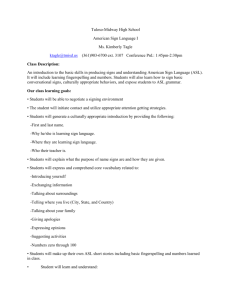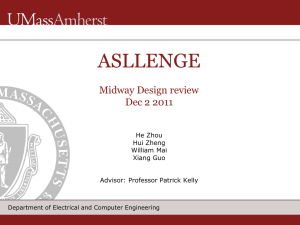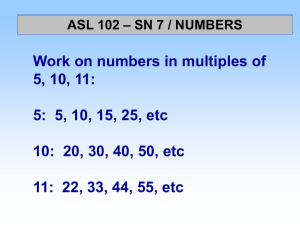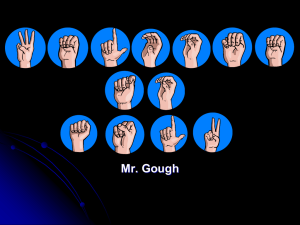PowerPoint Slides
advertisement
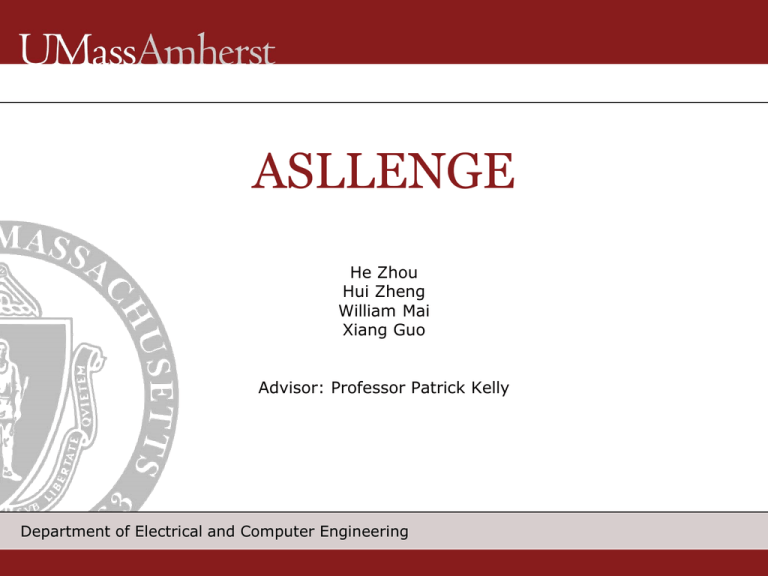
ASLLENGE He Zhou Hui Zheng William Mai Xiang Guo Advisor: Professor Patrick Kelly Department of Electrical and Computer Engineering Outline Background System Requirements Design Challenges System Overview Hardware and Software Team Roles Timeline Q/A Department of Electrical and Computer Engineering 2 Background Leverage Kinect technology to recognize and offer feedback on American Sign Language ASL is the one of most commonly used language in US(.5 to 2 million population use ASL as their primary form of communication) Educational learning tool for ASL Department of Electrical and Computer Engineering 3 Motivation Helping hearing impaired people to learn ASL. Facilitate communication between ASL speaker and non-speaker Department of Electrical and Computer Engineering 4 System Requirements Create a user-friendly interface that recognize sign language and offer feedback • Software must be easy to use Display translated word or phase being demonstrated by user • Provide quality feedback to user concerning the accuracy of ASL Cost should be within the budget Department of Electrical and Computer Engineering 5 Design Challenges Human Factors Background Interferences Finger Gestures Hardware limitation • Kinect only has 320x240 resolution and 16 bit depth Department of Electrical and Computer Engineering 6 Kinect Has a depth and regular Camera Associated with software development kit • Able to track a human being. • Use computer generated algorithms to form human skeleton data points Track upper body movements Department of Electrical and Computer Engineering 7 System Overview Department of Electrical and Computer Engineering 8 Video demonstration(Hand Rotation) Department of Electrical and Computer Engineering 9 Video demonstration(Hand Crossing) Department of Electrical and Computer Engineering 10 Video demonstration(Hand behind Head) Department of Electrical and Computer Engineering 11 Video demonstration(Hand behind Back) Department of Electrical and Computer Engineering 12 Hardware Implementation 1 Increasing the flex sensor output voltage with bend Voltage output goes into an AD converter board AD converter digitizes the output signal PC captures the signal via USB or Bluetooth Department of Electrical and Computer Engineering 13 Hardware Implementation 2 Kinect Camera captures the raw image and the depth image data The data send to PC to be processed into skeleton tracker Combining the signal from flex sensor and search in database for matching motions Department of Electrical and Computer Engineering 14 Software Design Flow Department of Electrical and Computer Engineering 15 Development Model Department of Electrical and Computer Engineering 16 Cost of Major Components Name of Component Flex Sensor A/D Converter Board A Pair of Gloves Kinect Sensor Bluetooth Module Quantities 10 1 1 1 1 Unit Price $12 $50 $10 $150 $20 Total Price Department of Electrical and Computer Engineering $350 17 Team Roles He - test and integrate software prototype Hui- image processing and programming William - build microcontroller to detect finger and palm movements Xiang- website, overall testing and building ASL database Department of Electrical and Computer Engineering 18 MDR deliverables The goal for our MDR is to be able to detect and track arm and hand positions, possibly be able to translate simple hand gestures Department of Electrical and Computer Engineering 19 Conclusion Our project is good for SDP: • Contains both hardware and software • Expandable: database, audio recognition, braile Our project is a good product: • Aid the disabled people • Personal/commercial use • Relatively inexpensive Department of Electrical and Computer Engineering 20 Timeline 10/16/2011 12/5/2011 1/24/2012 3/14/2012 5/3/2012 PDR Purchase Parts Planning GUI Interface with the Sensors Build Finger Sensors Build Test Database Prototype 1 MileStone MDR Deliverables System Integration Winter Break Expand Database Prototype 2 MileStone CDR Deliverables Alpha Testing Update Beta Testing Spring Break Finalize Project MileStone FRP Deliverables Department of Electrical and Computer Engineering 21 Q&A Department of Electrical and Computer Engineering 22
